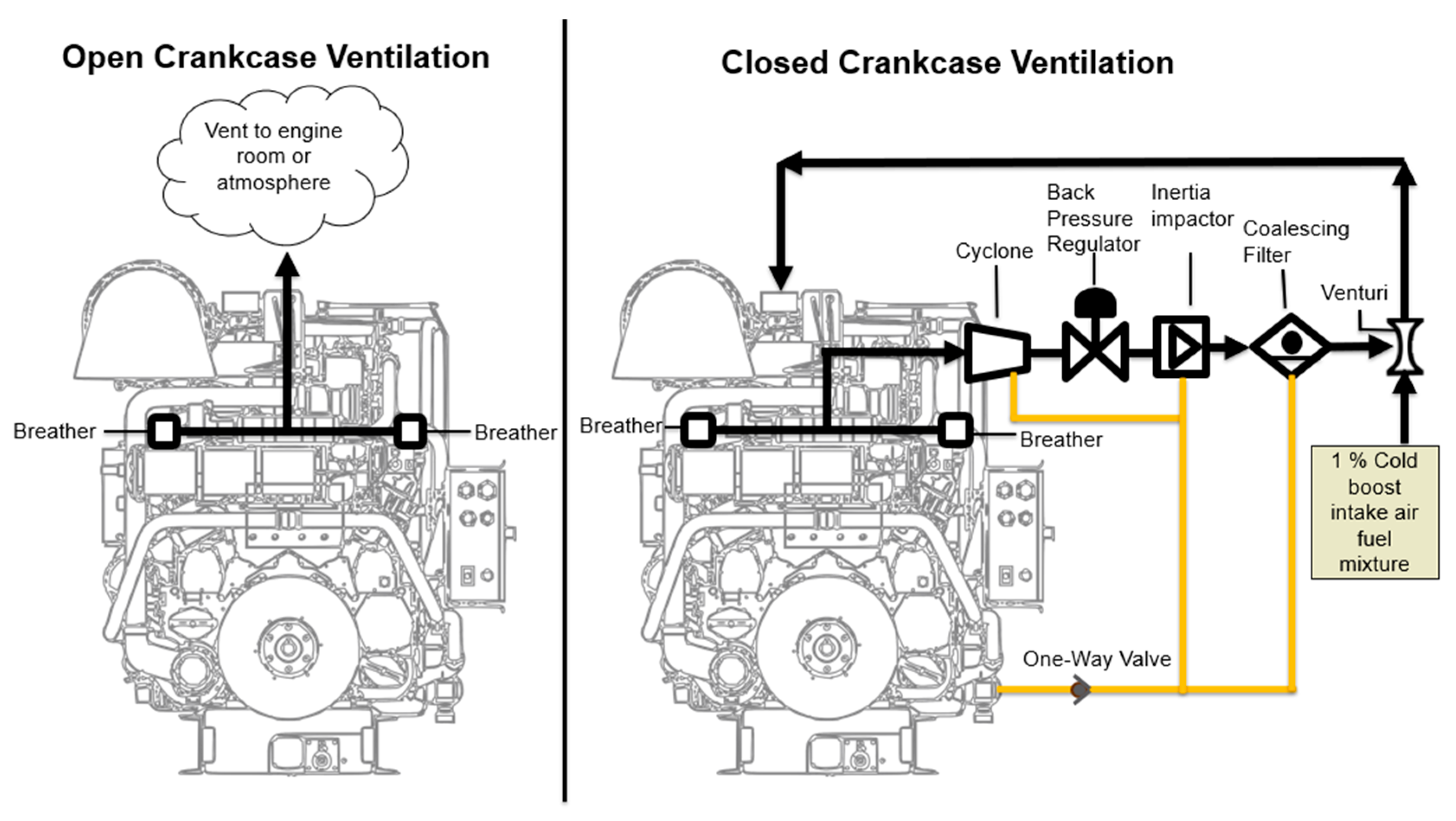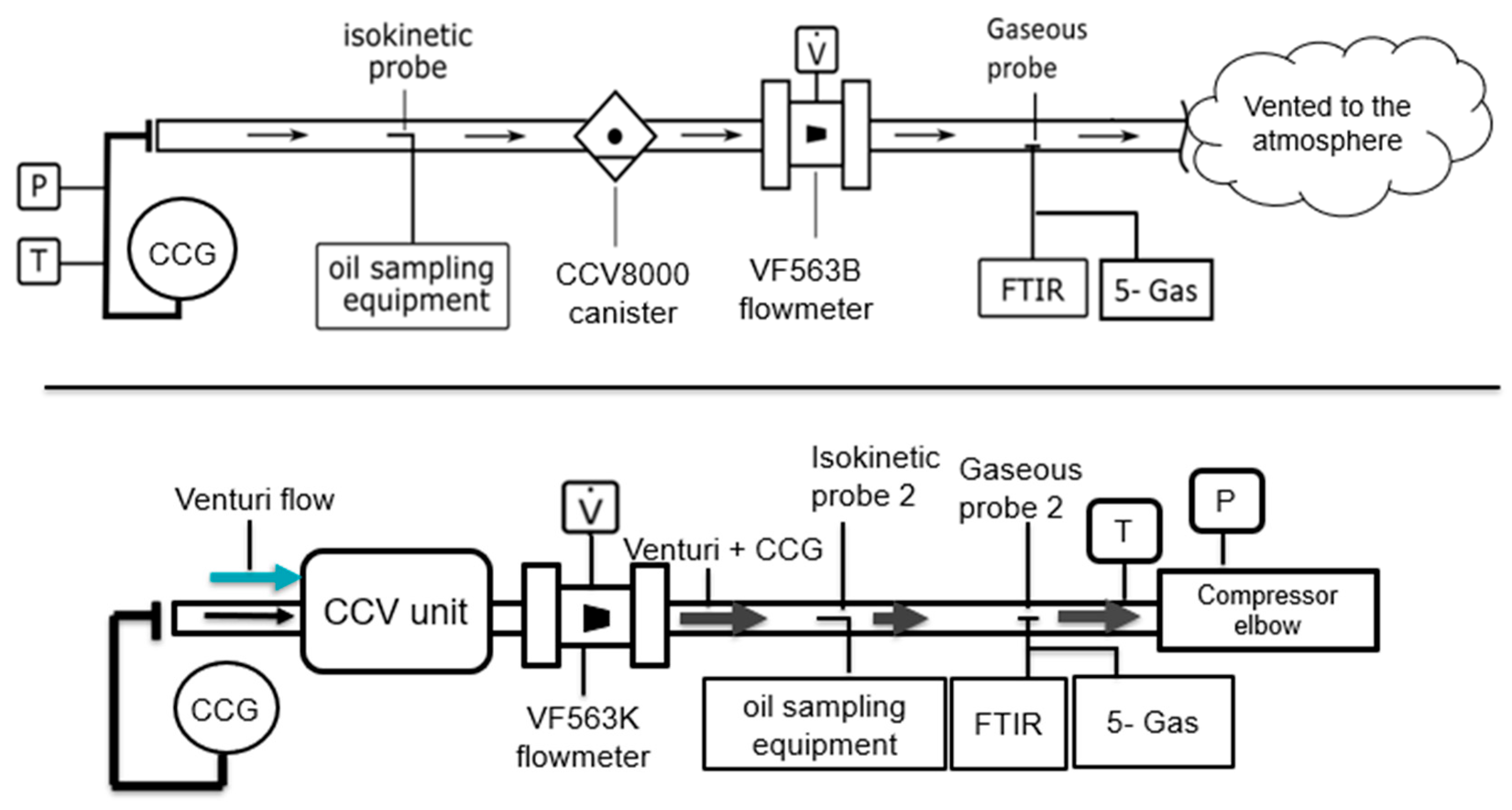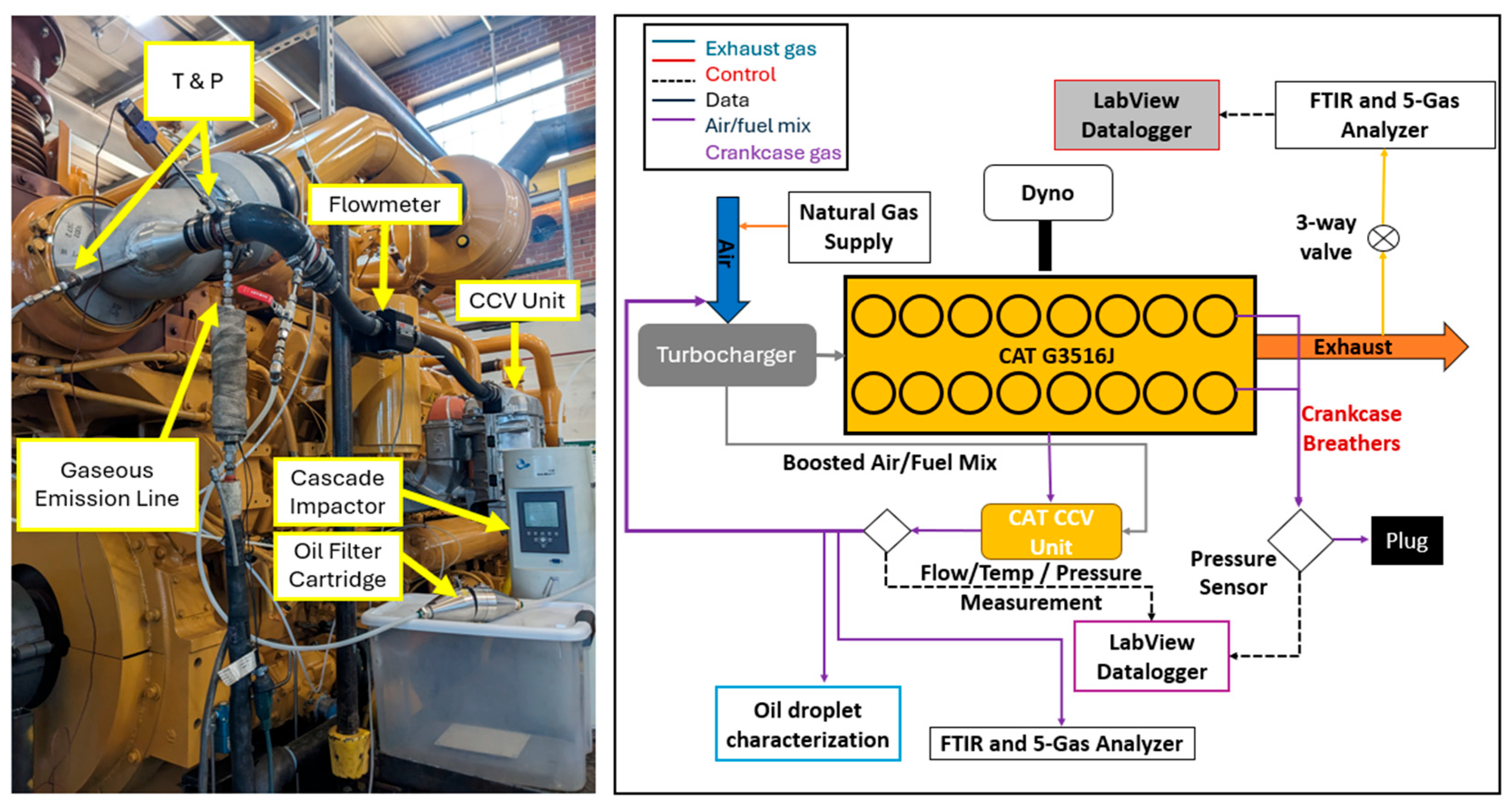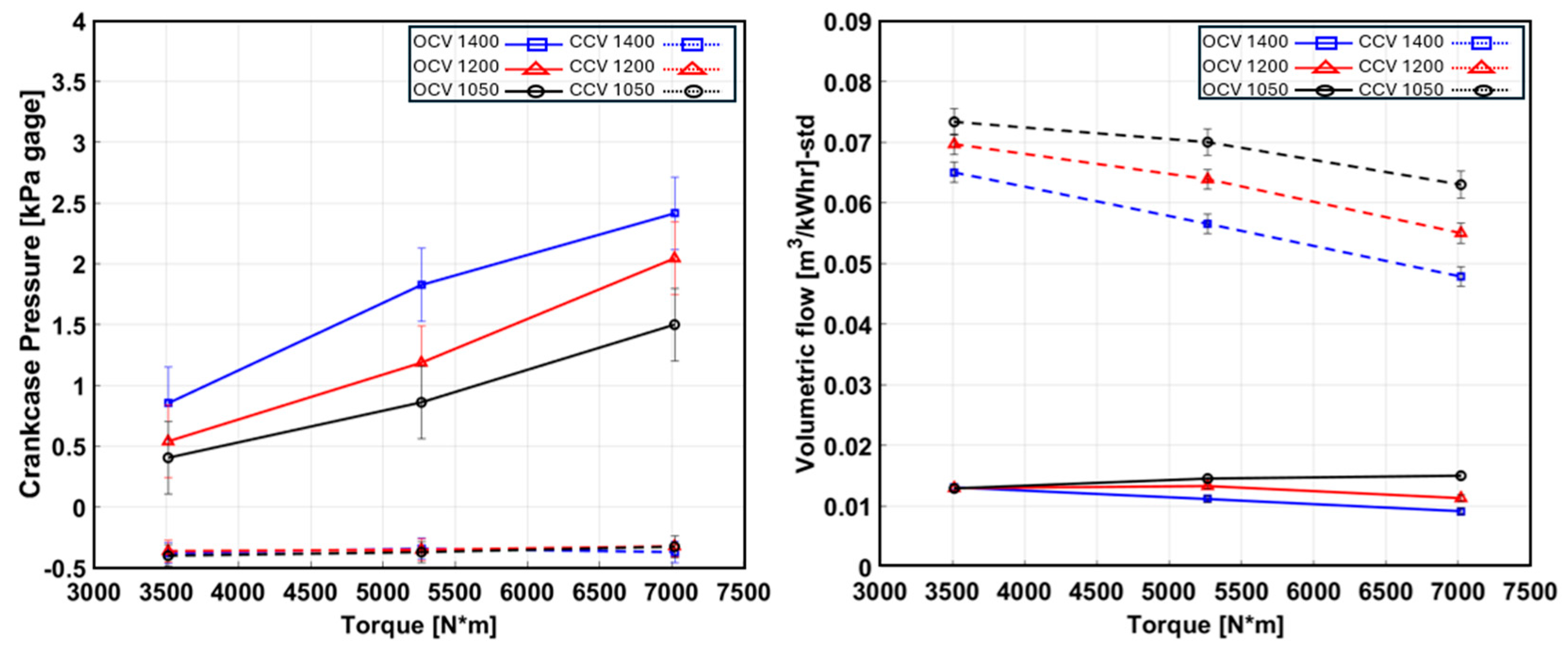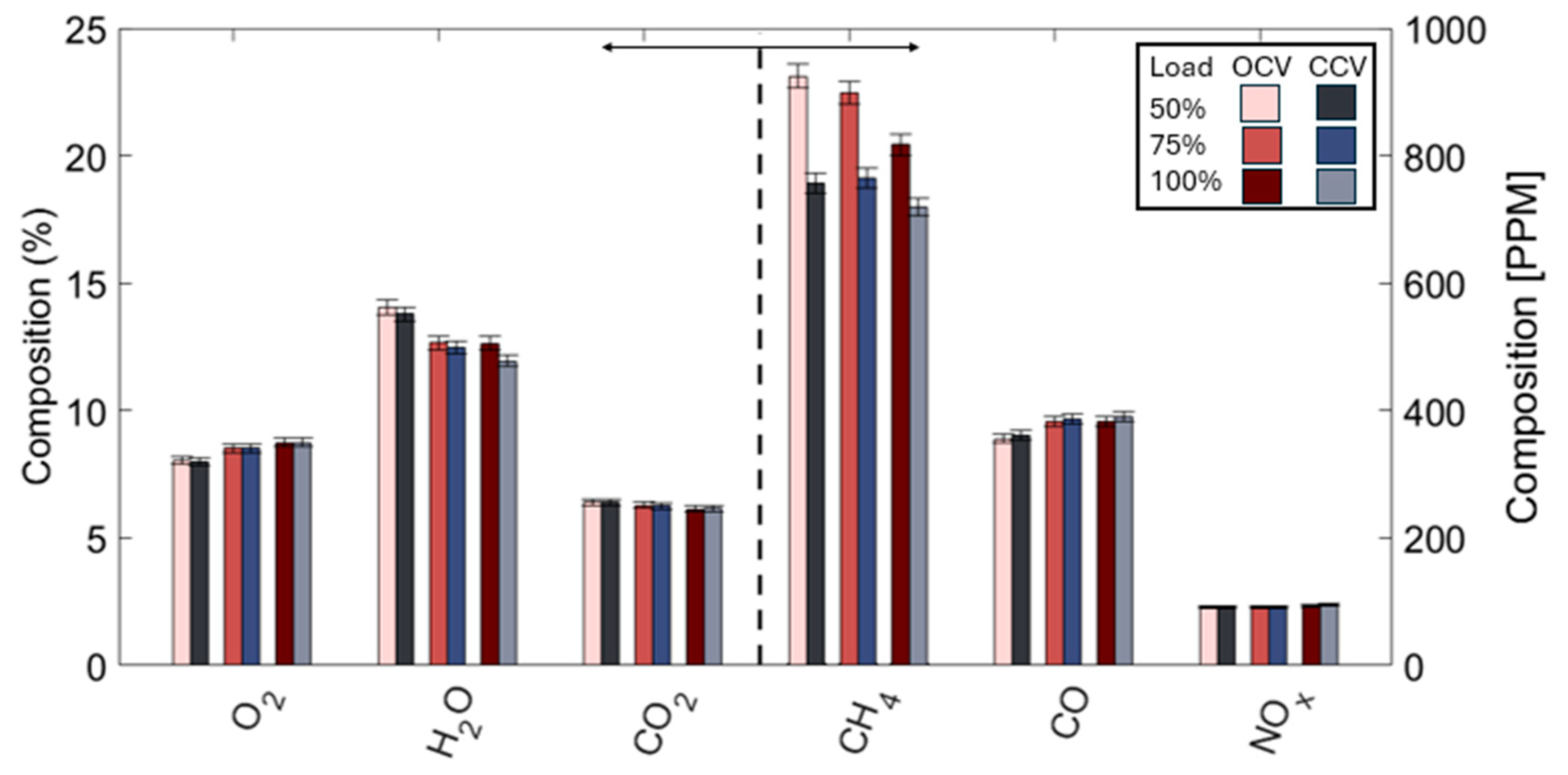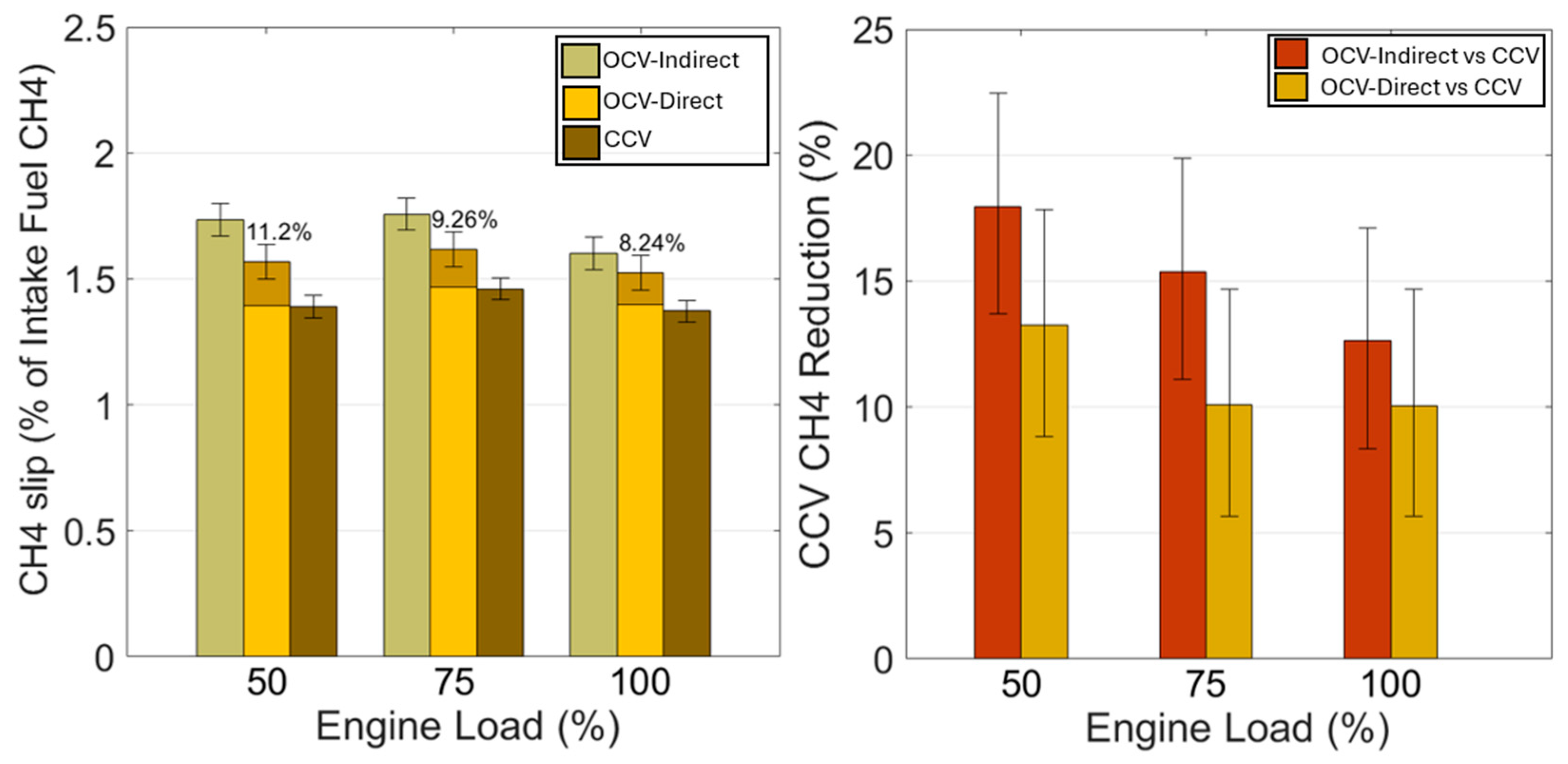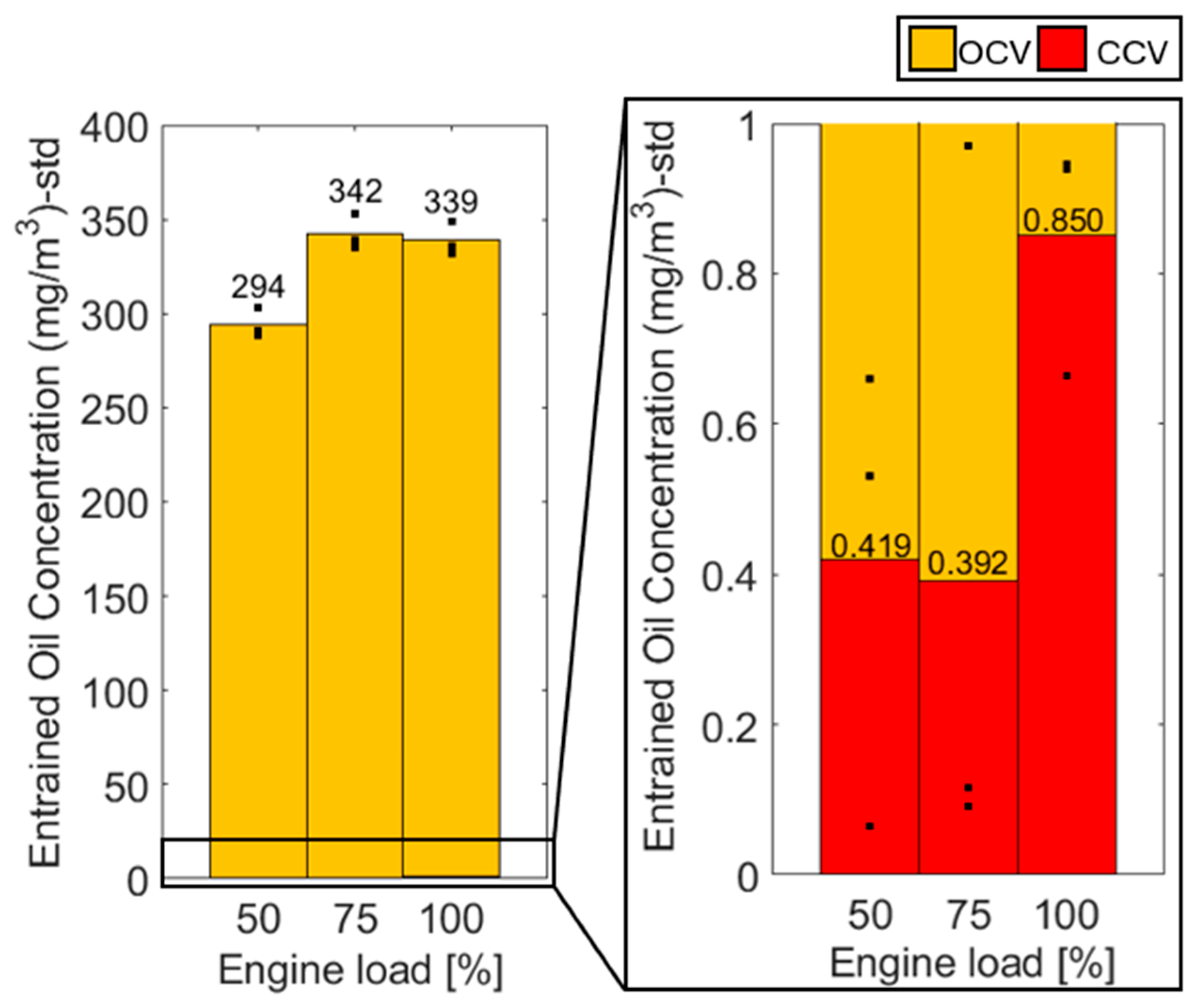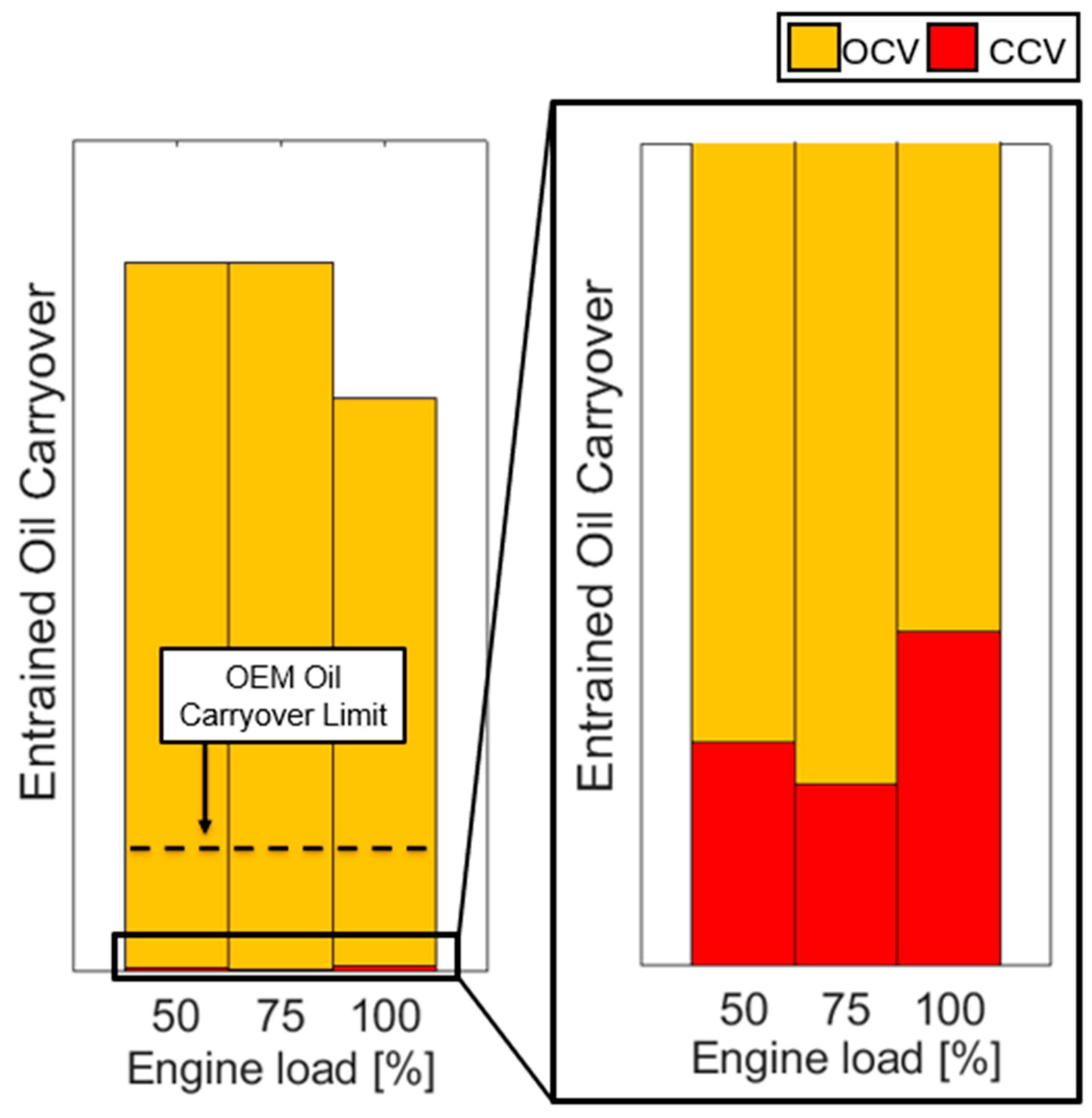1. Introduction
Natural gas (NG) has played a key role in meeting global energy demand. In 2022, NG accounted for 23.1% of the total energy supplied worldwide [
1]. In the United States, it is the second most widely used energy source after oil, comprising 35.3% of the total energy supply in 2023 [
2]. NG is a popular alternative fuel due to its relatively low emissions, high heating value, widespread availability, and competitive cost. Its primary constituent, methane (CH
4), has a lower carbon-to-hydrogen ratio than conventional fuels such as fuel oil, coal, and gasoline, resulting in lower CO
2 emissions per unit of energy produced. Despite of producing less CO
2 when combusted, NG combustion systems are susceptible to “methane slip,” wherein a fraction of the CH
4 entering the combustion chamber remains unburned. Although CH
4 has a shorter atmospheric lifetime than CO
2, it is significantly more potent as a greenhouse gas (GHG), with a global warming potential 28 times greater than that of CO
2 over a 100-year period [
3]. In 2022, methane emissions represented 12% of all U.S. greenhouse gas emissions from anthropogenic sources [
4]. In response, legislation such as the Inflation Reduction Act (IRA) was enacted to mitigate CH
4 emissions. The IRA imposes penalties on petroleum and natural gas facilities emitting more than 25,000 metric tons of CO
2-equivalent per year. The waste emission charge begins at
$900 per metric ton of CH
4 in 2024, increasing to
$1500 per metric ton by 2026 and beyond [
4].
The Department of Energy (DOE) has set a target for CH
4 conversion efficiency of ≥99.5% to reduce CH
4 slip emissions [
5]. Achieving this goal requires the integration of multiple technologies into NG systems. For industrial NG engines, which approximately account for 25% of CH
4 emissions of the U.S NG gathering and boosting sector [
6], there are multiple promising technologies to reduce CH
4 emissions. These include Closed Crankcase Ventilation (CCV), CH
4 oxidation aftertreatment catalysts, and low crevice volume pistons. This paper focuses on evaluating the performance and effects of the CCV system and its effectiveness in reducing CH
4 emissions originating from crankcase gas (CCG), also referred to as engine blow-by, in a lean-burn natural gas stationary engine.
The function of the CCV system is to filter and recirculate CCG while maintaining acceptable engine operational stability. CCG consists of a mixture of unburned fuel–air, exhaust gases, and oil mist, that flows into and out of the engine crankcase. During the compression and expansion strokes, both unburned and burned gases in the combustion chamber are forced into the piston crevice volumes [
7]. These crevices volumes are narrow regions between the piston crown, piston rings, and cylinder wall, where the combustion flame is quenched by heat transfer to the cooler crevice surfaces contributing to hydrocarbons leftover. During the expansion stroke, some of the gas in the crevice volume flows back into the combustion chamber, while the remainder escapes into the crankcase as CCG or blow-by [
7]. If not properly managed, CCG can accumulate in the engine crankcase and cause engine crankcase over-pressurization, potentially damaging oil seals and degrading engine performance. In most industrial engines, the conventional Open Crankcase Ventilation (OCV) system vents CCG directly to the atmosphere to prevent engine crankcase over-pressurization (
Figure 1 Left). While effective at pressure control, this result in the loss of fuel and hydrocarbon (HC) emission, mainly CH
4. The CCV system addresses this inefficiency by recirculating CCG to the intake manifold, giving the unburned CH
4 and other HCs another opportunity for combustion. This recirculation can enhance thermal efficiency by reducing fuel loss.
In this study, the CCV system was installed on one of the engine cam covers and connected upstream of the turbocharger compressor. The system included oil separation components, a backpressure regulator, a venturi, and a one-way valve to enable effective oil recirculation without compromising engine performance (
Figure 1 Right). A major challenge in CCG recirculation is the presence of oil particles, which must be thoroughly removed to prevent fouling of critical components such as turbochargers, valves, aftercoolers, and after-treatment systems. Such fouling can significantly impair engine efficiency and performance [
8]. Subsequent work will study the CCV system durability and reliability tested in a one-year field test performance, as well as piston ring pack geometry and fluid dynamics that produce CCG emissions.
2. Materials and Methods
The engine used in this study was a Caterpillar G3516J four-stroke, lean-burn, spark-ignition (SI) engine (
Table 1), commonly employed in gas compression applications. This engine was donated to Colorado State University by a midstream company, Western Midstream, and was rebuilt by Wagner Caterpillar. It was in new condition at the beginning of the laboratory testing.
2.1. The CCV Unit
The CCV unit used in these experiments was also newly deployed. The CCV system consisted of multiple components, as shown in
Figure 2. The first stage of the CCV unit was a screen filter, which removed larger oil droplets from the CCG. The second component consisted of heater elements located on the top and front surfaces of the CCV housing. These heaters were intended to prevent vapor condensation and to aid drainage by reducing oil viscosity under freezing conditions; however, they were not used during any of the tests. Following the heater elements, a cyclone separator targeted larger oil particles. The cyclone introduced a swirling motion to the gas stream, creating a centrifugal force that pushed entrained oil particles toward the walls of the chamber, where they were drain back to the engine crankcase by gravity.
Downstream of the cyclone was a backpressure regulator that controlled the vacuum applied to the crankcase by the engine turbocharger compressor and the venturi system. This regulator, referenced to atmospheric pressure, maintained the crankcase pressure slightly below atmospheric levels. The regulator operated by dithering—modulating its position to maintain the desired crankcase pressure. At high engine loads, when the turbocharger and venturi generated a high vacuum, the regulator reduced the flow area to limit vacuum levels in the crankcase. At idle or low-load conditions, when vacuum decreased, the regulator increased the flow area to maintain adequate evacuation.
Following the pressure regulator was an inertial impactor designed to remove coarse aerosol particles (10 µm > d > 2.5 µm). This device functioned by forcing the gas to abruptly change direction around an impaction plate. Particles with sufficient inertia deviated from the gas stream and impacted on the plate surface, thereby separating from the flow [
9]. The final filtration stage was a coalescing filter, which trapped fine oil aerosol particles (d < 2.5 µm) through an inside-out flow configuration. Within the filter media, smaller particles coalesced to form larger droplets, which then drained by gravity back to the crankcase oil reservoir.
The CCV unit also featured a venturi, which prevented crankcase over-pressurization and facilitated CCG flow from the crankcase to the engine intake. This venturi effect was enabled by diverting approximately 0.7% to 1% of the intake cold premixed air–fuel flow—referred to as the “venturi flow.” The final component of the CCV system was a one-way check valve installed in the oil drain line. This valve permitted the return of filtered oil to the crankcase while preventing reverse flow of oil from the crankcase into the engine intake.
2.2. CCG Measurement Probe
CCG characterization, measurement probes were assembled by the CSU research team. In the Open Crankcase Ventilation (OCV) configuration, the probe enabled measurement of temperature, pressure, oil concentration, oil distribution, gas flow rate, and gas composition of the CCG (
Figure 3 Top). In the Closed Crankcase Ventilation (CCV) configuration, the probe was used to characterize the gas flow rate, oil concentration, oil distribution, gas composition, temperature, and pressure of the CCG and venturi flow mixture downstream of the CCV unit (
Figure 3 Bottom).
In the OCV configuration (
Figure 3 Top), a CCV8000 canister acted as an oil dropout drum upstream of the flow meter to prevent excessive oil contamination and to dampen pressure fluctuations for more stable flow measurements. JTEC flowmeters based on vortex shedding were used, with a repeatability of ±0.5% and an accuracy of ±2% of full scale. The VF563B model, with a measurement range of 1 to 27 m
3/h was employed. To ensure reliable measurements, the flow meter required 20 pipe diameters of undisturbed flow upstream and 10 diameters downstream [
10]. In the CCV configuration (
Figure 3 Bottom), measurement instruments were placed downstream of the CCV unit. A higher capacity VF563K flow meter was used, covering a range of 1.6 to 79 m
3/h, to accommodate the added venturi flow. A modified isokinetic probe was fabricated and used due to the presence of the venturi flow. The major constraint in this setup was limited space, which prevented full adherence to the required sampling lengths for the isokinetic probe, gaseous probe, and flow meter. Additionally, temperature and pressure were measured downstream of the CCV unit.
The oil sampling system consisted of a near-isokinetic sampling probe, a controller, a vacuum pump, a filter cartridge device, and a Nano-Moudi cascade impactor. The isokinetic probe was designed to match the velocity of the gas in the pipe to that at the probe entrance. For accurate particulate matter (PM) sampling, the probe location followed US EPA guidelines for gas sampling which required eight pipe diameters of undisturbed flow upstream and two pipe diameters downstream [
11]. This setup was achieved in the OCV configuration but could not be met in the CCV configuration due to spatial limitations.
In both configurations, oil concentration samples were collected using a filter cartridge containing a Teflon filter followed by a Quartz filter. The Teflon filter captured PM, while the Quartz filter trapped both PM and organic vapors. The Quartz filters primarily served to prevent oil mist from contaminating downstream equipment and were not analyzed. The analysis focused on PM, which can be divided into organic carbon (OC) and elemental carbon (EC). Based on Olsen et al., PM in natural gas engines is predominantly OC, primarily derived from lubricating oil [
12]; therefore, EC was considered negligible for this study. The Teflon filters were subjected to gravimetric analysis to determine gas oil concentration and, ultimately, oil carryover for both configurations.
The Nano-Moudi cascade impactor featured thirteen impaction stages with aluminum filters and one stage with a Teflon filter. It collected oil droplets across a range of aerodynamic diameters. In each stage, the gas sample passed through a nozzle and impinged on a downstream plate with a filter. Particles with sufficient inertia deviated from the streamlines and impacted the filter, while smaller particles followed the flow to the next stage. As the nozzle size decreased through the stages, the particle cut-off diameter also decreased, enabling sequential removal of larger particles first.
The final components of the measurement system included gas sampling hardware: a gaseous probe, an emission-heated sample line, an MKS Model 230 Fourier Transform Infrared (FTIR) spectrometer, and a 5-gas analyzer. The CCG was sample following EPA sampling location [
11] and transported through the emission heated sample line to both the FTIR and the 5-gas analyzer for compositional analysis.
2.3. Data Collection
Data collection was conducted over multiple testing days. Key performance metrics such as total CH4 slip, CCG CH4 slip, CH4 reduction achieved by the CCV system, and CCV oil filtration efficiency were determined by comparing results between OCV and CCV configurations. The OCV configuration was further divided into two sub-configurations for quantifying emissions, referred to as the “Direct OCV” and “Indirect OCV” configurations. Both were used as baselines for comparison with the “CCV” configuration.
2.3.1. Direct OCV Configuration
The “Direct OCV” configuration involved directly measuring the exhaust CH
4 slip and the CCG CH
4 slip, then summing them to calculate the total engine CH
4 slip. The total CH
4 slip and corresponding CH
4 reduction in this method were calculated using Equations (1)–(9). In this configuration, the CCG sample was extracted from cam cover 11 (
Figure 4 Top-Left), as this was the location where the CCV system was installed. Maintaining this sampling location ensured consistency across configurations. The CCG was routed through the OCV measurement probe and vented outside the engine lab (
Figure 4 Top-Right).
Figure 5 presents a schematic of the Direct OCV configuration, detailing the CCG flow path and instrumentation used to measure CCG pressure, temperature, flow rate, and chemical composition. All measurements were conducted at three engine speeds: 1400 RPM, 1200 RPM, and 1050 RPM, and three engine loads: 50%, 75%, and 100%. Each gas sample point was a five-minute average.
Oil concentration measurements were conducted under the same engine operating conditions. Each oil sample was collected over a duration of three minutes. For each load condition (50%, 75%, 100%) at 1400 RPM, three replicate samples were taken. At 1200 RPM and 1050 RPM, two samples were collected for each load. Oil droplet size distribution measurements using the cascade impactor were performed only at 1400 RPM and 100% load, with each sampling period lasting seven and a half minutes.
Equations (1)–(6) for Direct OCV:
where,
= CCG flow rate.
= CCG CH4 flow rate.
= intake fuel flow rate.
= intake air flow rate.
= CCG CH4 mole fraction.
= Exhaust CH4 mole fraction.
= CCG Molecular Weight.
= Exhaust Molecular Weight.
= CH4 flow rate in the exhaust (Direct OCV).
= CH4 flow rate into the engine.
= Total CH4 slip (OCV configuration).
2.3.2. Indirect OCV Configuration
The second method, referred to as the “Indirect OCV” configuration, involved physically connecting the crankcase vent to the exhaust system and measuring the CH
4 concentration downstream of the connection to determine the total CH
4 emissions. This flow connection was designated as the “CCG-Exhaust Connection” (
Figure 4 Bottom). In this configuration, no direct measurement of the CCG was performed. Instead, the method was only used to quantify the total CH
4 emissions from the engine and assess the CH
4 emission reduction achieved by the CCV system. For this setup, cam cover 11 was sealed, and the crankcase breathers were routed to the exhaust piping (
Figure 4 Bottom). In addition to the laboratory data acquisition system, which collected engine operating data from the Engine Control Module (ECM), a heated sample line was used to analyze the exhaust gas composition downstream of the CCG-Exhaust Connection. The Indirect OCV configuration served to increase confidence in the results by providing a simpler measurement setup with reduced instrumentation and, consequently, lower uncertainty. Furthermore, this method enabled a direct comparison of the total engine CH
4 emissions with and without the CCV system.
Equations (7) and (8) for Indirect OCV configuration:
where,
= Exhaust CH4 flow rate (Indirect OCV).
= Total CH4 slip (Indirect OCV).
= Exhaust and CCG total Molecular Weight.
2.3.3. CCV Configuration
In this configuration, measurements were performed downstream of the CCV unit (
Figure 6 Left). Crankcase ventilation gas temperature, pressure, volumetric flow rate, and gas chemical composition were monitored, with each gas sample collected over a five-minute duration, consistent with the OCV configurations. However, particulate matter (PM) sampling durations were doubled compared to the OCV setup to ensure sufficient oil mass accumulation on the filters, thereby reducing measurement uncertainty. This extended sampling duration was necessary to compensate for the lower oil mass expected downstream of the CCV unit due to its filtration efficiency and to minimize the effect of instrumentation error. Consequently, oil concentration samples were collected over a six-minute period, while oil distribution measurements lasted 15 min. The CCV schematic (
Figure 6 Right) illustrates the flow path of this recirculated gas along with the instrumentation used to characterize it. The schematic also shows how the engine breathers were sealed, and a pressure sensor was installed to monitor crankcase pressure. In this configuration, exhaust gas was sampled to determine the engine total CH
4 emissions and to calculate the CH
4 reduction achieved by the CCV system relative to both OCV configurations. Equations (9)–(11) were used for this analysis.
where,
= Exhaust CH4 flow rate (CCV configuration)
= Total CH4 slip (CCV configuration)
= CH4 reduction by CCV implementation
2.4. Uncertainty Analysis
Crankcase pressure, crankcase ventilation flow, BSFC, and the CCV CH
4 reduction uncertainty was calculated to provide a more accurate assessment of the CCV system performance. Uncertainty analysis was performed using Equations (12)–(18) based on (Wheeler and Ganji 2009, 199) [
13]. The total error of a variable was calculated by combining the instrumentation error and random error of that variable. The instrumentation error was calculated by searching the accuracy of every instrument used in the experiments and multiply by the instrument output scale or reading. Those errors were input it in the root of the sum of the squares (RSS) equation (Equation (13)) to account for the error propagation in the calculated variables. The random error was determined by selecting a specific engine operational load (100% load) at each speed for each configuration. The standard deviation of the measured variables was determined with a 95% confidence interval, and the standard deviation of the calculated variables was calculated by using Equation (16), which factors in the standard deviation of the measured variables. The final uncertainty of each variable was a combination of the instrumentation and random error, and it was calculated by Equation (18). This analysis revealed that the OCV-Direct method had a slightly higher uncertainty compared to the OCV-Indirect method due to the additional instrumentation used to characterize the CCG in the OCV-Direct method.
Uncertainty Equations (12)–(18)
Instrumentation Uncertainty
where,
_error = Measured or independent variable instrumentation error at Full Scale (FS)
= Change of the calculated or dependent variable relative to an independent variable.
= Dependent variable calculated instrumentation error.
Random Uncertainty
where,
= average value of measured or independent variable.
= number of data points.
= standard deviation of measured or independent variable.
= Change of the calculated or dependent variable relative to an independent variable.
= standard deviation for calculated dependent variable.
Student’s t statistic for 95% confidence interval.
= Random Uncertainty for dependent variable.
Total Uncertainty
4. Conclusions
The integration of the Closed Crankcase Ventilation (CCV) system into engine operations resulted in significant improvements in engine performance, emissions control, and oil management. The study demonstrated that the CCV system effectively reduces pumping work and parasitic losses which leads to an increase in engine efficiency. Additionally, the CCV system reduced total engine CH4 emissions, with reductions ranging from 12% to 18% compared to the Indirect Open Crankcase Ventilation (OCV) configuration, and 10% to 13% compared to the OCV-Direct configuration. This reduction in engine CH4 emission is indicative of improved thermal efficiency, which leads to lower unburned hydrocarbons.
Additionally, the CCV system contributed to a marked decrease in oil consumption and particulate matter (PM) emissions. The oil concentration in crankcase gases (CCG) was significantly lower in the CCV configuration, and the system exhibited excellent filtration efficiency, achieving values between 99.23% and 99.91%. The analysis of oil particle size distribution showed that the CCV system significantly reduced the concentration of different oil particles sizes, thus preventing potential engine component fouling and reducing maintenance costs.
Overall, the results affirm the effectiveness of the CCV system in mitigating CCG CH4 emissions while preserving engine functionality and reducing long-term operational costs. Future research related to CCV system durability and reliability would give further insights into the maintenance that the system needs to keep performing effectively.
